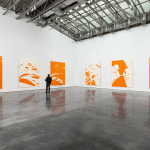Back when I was an art student in Boston, everyone swooned over Adam Cvijanovic’s amazing command over paint and powerful subjectmatter, so I’m looking forward to seeing his ambitious new show based on D. W. Griffith�s 1916 silent epic �Intolerance,� at Bellwether this month. In the NY Times, Carol Kino profiles the irrepressible painter.�’I�m basically making a painting about hubris,’ Cvijanovic said, ‘and it�s tempting fate to do that.’ As he readily admits, he has been burned by hubris in the past. At the age of 17 he dropped out of high school in Cambridge, Mass., to devote himself to painting. ‘I wanted to cut off my options,’ he said. ‘No teaching, no second profession, no out.’ By his early 20s Mr. Cvijanovic had become well known in the Boston area for being ‘a kind of prodigy making figurative paintings,’ said Gary Garrels, chief curator of the Hammer Museum in Los Angeles, who was working in Boston at the time. In 1985 Mr. Cvijanovic moved to New York, and his expressionistic narratives � one presented a mammoth Lower East Side streetscape filled with people � allowed him to crest the 1980s market boom.
“By the end of the decade, while living off a gallery credit card, he began to incorporate wire, fabric and even cars into his work. The resulting installations and reliefs were a critical flop, and his market began to dry up. He said he had been stunned and wounded by this fall from grace, something he now ascribes to hubris. But Mr. Garrels said he saw the situation differently. ‘I think that Adam felt that painting came too easily to him,� he said. �His facility was so natural that he had to create problems that he had to solve.’ During the art market crash of the early 1990s Mr. Cvijanovic turned to decorative painting to get by, and specialized in landscape murals. (One early client was the collector Henry Buhl; Mr. Cvijanovic�s trompe l�oeil painting helped transform Mr. Buhl�s SoHo loft into a Renaissance palazzo.) When Mr. Cvijanovic resurfaced in the art world some years later he was painting grandly scaled landscapes that seemed to embrace many of the conventions of 19th-century American painting, like its sublime take on nature and its awe-inspiring illusionism. Made with house paint and Flashe, a French vinyl acrylic, on Tyvek, the paintings could also be moved and reinstalled with ease. Mr. Cvijanovic referred to them as ‘wallpapers,’ a contrarian stance that put him precisely in tune with the post-postmodernist times.” Read more.
“Adam Cvijanovic’s Colossal Spectacle,” Bellwether, New York, NY. Through July 3.























“Lived off his gallery credit card”–I’ve known Adam for years and this is bullshit. He actually lived off his wife, who worked two jobs so he could paint undisturbed. He dumped her for a 22 year old the minute Saatchi discovered him, which was not so nice because wifey was in bed recovering from cancer. Hes a great artist but not a very nice person.
The above statement is true. What an ass.